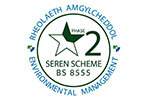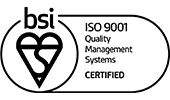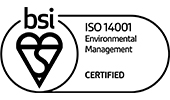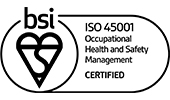Recently, you may have heard the concept of biophilia being mentioned as a growing (pun intended) trend in office design.
In our own 2017 office design trends and colour trends blogs, the Paramount design team highlighted both greenery in the workplace and the idea of bringing the outside into an office.
So we thought it was about time we took a broader look at biophilia and what it means.
What is biophilia?
First introduced in the 1980s by the entomologist, Edward O. Wilson, biophilia is a scientific field of research about the human connection to nature and how it can improve our health and well-being. He said that “life around us exceeds in complexity and beauty anything else humanity is ever likely to encounter.”
Biophilic design attempts to connect the natural world with our working environment by giving people access to living things.
While some animals like dogs are welcome in the workplace, you’re more likely to see this represented by the inclusion of plants in a working environment, especially the recent trend for living walls.

Biophilia and productivity
For many years, biophilic design would have been seen as a luxury for employers wanting to create an impactful workplace or showcase their environmental efforts.
Thanks to recent research into the positive impact on employee well-being, absence management and productivity, it’s been embraced by more businesses.
Environment consultants, Terrapin Bright Green explored this in their white paper; The Economics of Biophilia. It cites a study which looked at the number of calls handled by employees at the Sacramento Municipal Utility District Call Center. Calls taken by employees with views of vegetation exceeded the number of calls taken by employees with no view of the outdoors.
It also found that 10% of absenteeism could be attributed to a lack of access to nature. Also, in general, access to natural light, outdoor views, and ventilation reduced eye strain and relieved mental fatigue.
A study by virtual forum Human Spaces found that, from a sample of 7,600 workers across 16 countries, people working in offices offering natural features had a 15% higher sense of wellbeing and were 6% more productive.

Image source: Cook+Fox Architects, Ryan Browne
When it comes to biophilia, Terrapin Bright Green practise what they preach. Their New York offices feature a green roof system which, as well as providing energy benefits and absorbing stormwater, creates a pleasant work atmosphere that aids their recruitment process.
Biophilia and air quality
You’ll breathe a lot easier in a biophilic office. Indoor plants in the workplace create higher levels of oxygen and reduce C02 levels. They also have air filtering qualities, removing impurities and improving air quality.
A Harvard Business Review study showed a clear relationship between poor air quality and reduced productivity. While research by a team from Harvard, Syracuse University and SUNY Upstate found that improved air quality also improved cognitive functioning.
If you want some advice on the best plants for the job, NASA put together this handy list of the best air-cleaning plants.
Bringing biophilia into the workplace
A Portuguese co-working space for creative companies took this concept one step further by filling it with more than 2,000 individual plants and trees from 100 different species.
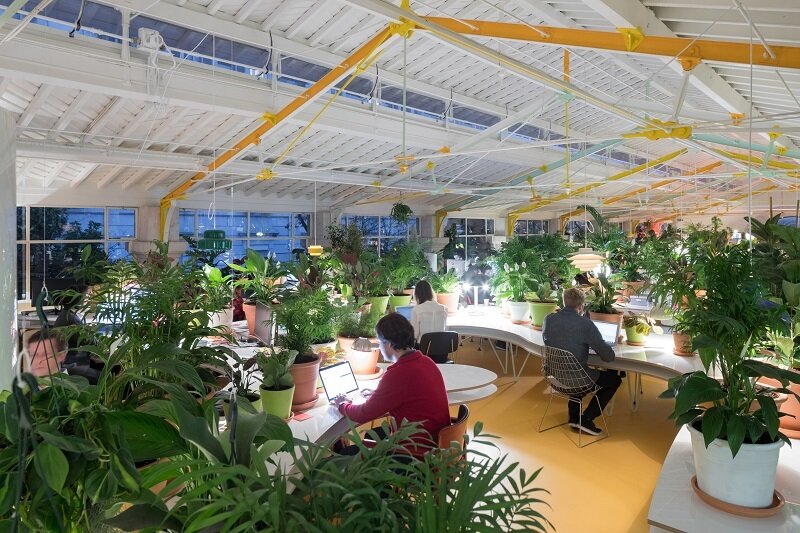
Photography: Iwan Baan
We’d be the first to admit that an example like this isn’t always going to be practical in terms of available space or the best use of budget for an office fit-out project. However, businesses needn’t be quite so radical in their approach to bringing the outside in.
Bringing biophilia into your office design
Referencing the research into biophilia undertaken since Edward O. Wilson’s book in 1984, Terrapin Bright Green published a report into the patterns of biophilic design which covered three areas.
We’ve collected these together with some suggestions on how a workplace could bring biophilic design into the workplace, without breaking your fit-out budget.
Nature in the space
This involves bringing actual examples of nature into the building.
- Pot plants on desks
- Living green walls
- Water features
- Fresh air circulation
- Natural light
- Windows with a view of trees, landscape or water
- Sound of birdsong or water
- Fish in aquariums

Our own ShowOffice not only has plenty of natural light but our breakout space overlooks an ornamental pond that we helped to revitalise and restore for the surrounding business park.
Nature of the space
This relates to the configuration of a space. It connects to the natural instincts and desires we have as human beings for safety, sociability and power.
- Cosy private workspaces
- Open-plan areas for collaboration
- Balconies and atriums that provide views from a height

The vast majority of our office design projects are built on the concept that a workplace should consist of a mixture of areas for the differing needs of staff. The design of S3 Advertising’s offices took an especially creative approach to the concept.
Natural analogues
These are manmade elements designed to mimic natural forms.
- Wood or stone-effect finishes
- Artwork depicting plants, animals or landscapes
- Shades of green, blue, yellow and brown
- Floral patterns
- Naturally chaotic shapes, curves and circles rather than angles and straight lines

For both GoCompare’s headquarters and KPMG’s South Coast offices, we introduced design elements that brought the outside in. This included fake grass flooring and a digitally-printed forest view.

If you’re interested in how you can incorporate elements of biophilic design into your workplace, give us a call.




